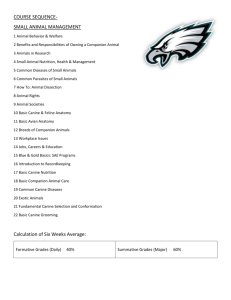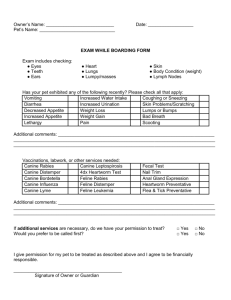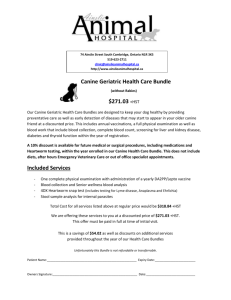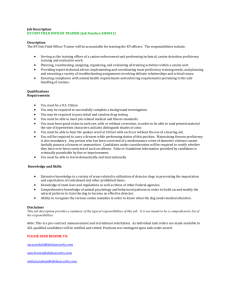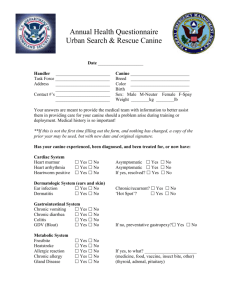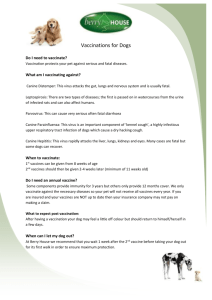CANIGEN DHPPi/L lyophilisate and suspension for suspension for
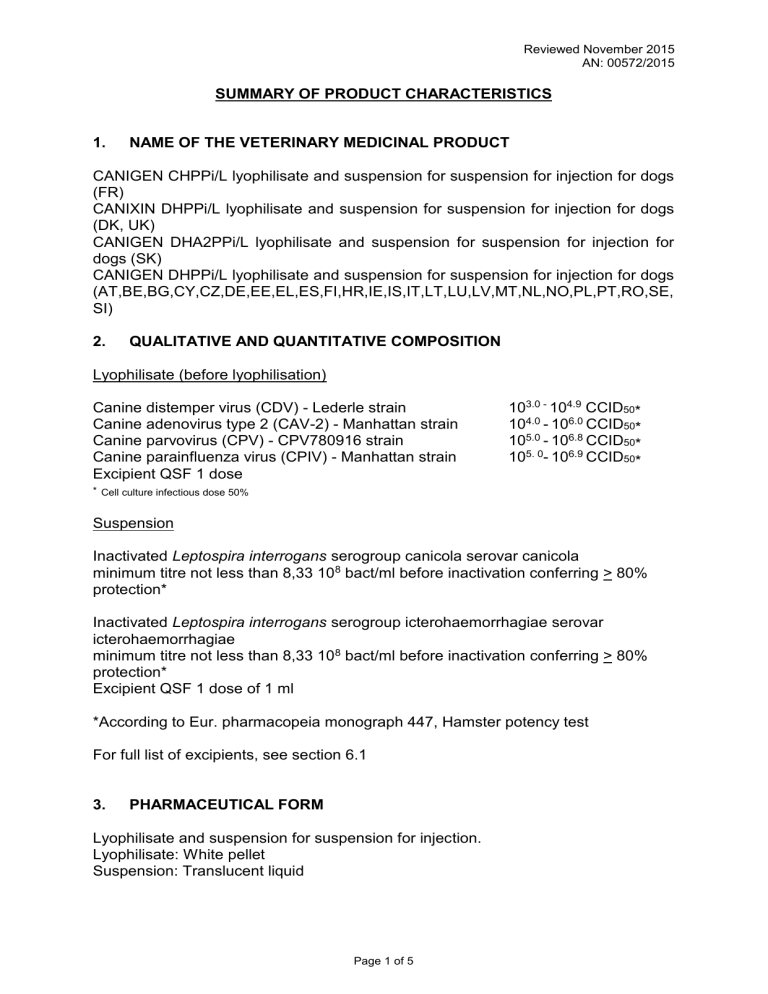
Reviewed November 2015
AN: 00572/2015
SUMMARY OF PRODUCT CHARACTERISTICS
1. NAME OF THE VETERINARY MEDICINAL PRODUCT
CANIGEN CHPPi/L lyophilisate and suspension for suspension for injection for dogs
(FR)
CANIXIN DHPPi/L lyophilisate and suspension for suspension for injection for dogs
(DK, UK)
CANIGEN DHA2PPi/L lyophilisate and suspension for suspension for injection for dogs (SK)
CANIGEN DHPPi/L lyophilisate and suspension for suspension for injection for dogs
(AT,BE,BG,CY,CZ,DE,EE,EL,ES,FI,HR,IE,IS,IT,LT,LU,LV,MT,NL,NO,PL,PT,RO,SE,
SI)
2. QUALITATIVE AND QUANTITATIVE COMPOSITION
Lyophilisate (before lyophilisation)
Canine distemper virus (CDV) - Lederle strain
Canine adenovirus type 2 (CAV-2) - Manhattan strain
Canine parvovirus (CPV) - CPV780916 strain
Canine parainfluenza virus (CPIV) - Manhattan strain
Excipient QSF 1 dose
10
10 4.0 10
10 5.0 10
10
3.0 -
5. 0 -
10
10
4.9
6.0
CCID
50
CCID
50
*
6.8 CCID
50
*
6.9 CCID
50
*
*
*
Cell culture infectious dose 50%
Suspension
Inactivated Leptospira interrogans serogroup canicola serovar canicola minimum titre not less than 8,33 10 8 bact/ml before inactivation conferring > 80% protection*
Inactivated Leptospira interrogans serogroup icterohaemorrhagiae serovar icterohaemorrhagiae minimum titre not less than 8,33 10 8 bact/ml before inactivation conferring > 80% protection*
Excipient QSF 1 dose of 1 ml
*According to Eur. pharmacopeia monograph 447, Hamster potency test
For full list of excipients, see section 6.1
3. PHARMACEUTICAL FORM
Lyophilisate and suspension for suspension for injection.
Lyophilisate: White pellet
Suspension: Translucent liquid
Page 1 of 5
Reviewed November 2015
AN: 00572/2015
4. CLINICAL PARTICULARS
4.1 Target species
Dog
4.2 Indications for use
For active immunisation of dogs from 8 weeks of age to:
prevent mortality and clinical signs of canine distemper and infectious canine hepatitis caused by canine adenovirus type 1;
prevent clinical signs and mortality and reduce excretion caused by canine parvovirus in challenge studies performed with a CPV-2b strain;
prevent clinical signs and reduce excretion caused by canine parvovirus in a challenge study performed with a CPV-2c strain;
reduce respiratory clinical signs and viral excretion caused by canine parainfluenza virus and canine adenovirus type 2;
prevent mortality and reduce infection, clinical signs, kidney colonisation, renal lesions and urine shedding of L. canicola and L. icterohaemorrhagiae ;
The onset of immunity has been demonstrated from 3 weeks after the primary vaccination for CDV, CAV-2 and CPV, 4 weeks for CAV-1 and CPIV, 5 weeks for L. canicola and 2 weeks for L. icterohaemorrhagiae.
The duration of immunity lasts for one year after the primary vaccination for all components. For CPV and CAV-1, the duration of immunity was demonstrated by serological data. For CPIV and CAV-2, the reduction of excretion was not significantly different in the duration of immunity studies.
4.3 Contraindications
None
4.4 Special warnings
After vaccination, the live viral vaccinal strains (CAV-2, CPV) can be spread to unvaccinated animals without any pathological effect for these in-contact animals.
The presence of maternally derived antibodies (puppies from vaccinated females) may in some cases interfere with the vaccination. Therefore the vaccination scheme should be adapted accordingly (see section 4.9).
4.5 Special precautions for use
Special precautions for use in animals
Vaccinate only healthy animals
Page 2 of 5
Reviewed November 2015
AN: 00572/2015
Special precautions to be taken by the person administering the veterinary medicinal product to animals
In case of accidental self-injection, seek medical advice immediately and show the package leaflet or the label to the physician.
Other precautions
None
4.6 Adverse reactions (frequency and seriousness)
After the administration of one dose of DHPPi/L vaccine most of the animals may exhibit a mild and transient swelling (
4 cm) or slight diffuse local oedema. This reaction resolves spontaneously within 1 to 12 days. In very rare cases pain and pruritus may occur. However these small transient injection site reactions resolve without treatment.
In very rare cases, the vaccination can induce a transient diarrhoea, hyperthermia or weakness. Hypersensibility reactions can be sometimes observed. In case of allergic or anaphylactic reaction, appropriate symptomatic treatment should be administered.
4.7 Use during pregnancy and lactation
Do not use during pregnancy and lactation.
4.8 Interaction with other medicinal products and other forms of interaction
No information is available on the safety and efficacy of this vaccine when used with any other veterinary medicinal product. A decision to use this vaccine before or after any other veterinary medicinal product therefore needs to be decided on a case by case basis.
4.9 Amounts to be administered and administration route
After reconstitution of the lyophilisate with the solvent, shake gently and administer immediately one dose of 1 ml subcutaneously according to the following vaccination schedule:
Primary vaccination course :
- first injection from 8 weeks of age
- second injection 3 or 4 weeks later.
Annual re-vaccination:
One booster injection of a single dose should be given 1 year after the second injection and annually thereafter.
Maternally derived antibodies may in some cases influence the immune response to vaccination. In such cases, a third injection is recommended from
15 weeks of age.
Page 3 of 5
Reviewed November 2015
AN: 00572/2015
4.10 Overdose (symptoms, emergency procedures, antidotes), if necessary
The 10 doses administration of the vaccine in one single injection site showed no other reactions than those mentioned in the sec tion “Adverse reactions” except for the duration of the local reactions (up to 26 days).
4.11 Withdrawal period(s)
Not applicable
5. IMMUNOLOGICAL PROPERTIES
ATCvet code QI07AI02
To stimulate active immunity against canine distemper virus, canine adenovirus, canine parvovirus, canine parainfluenza virus and L. interrogans serogroup canicola and L. interrogans serogroup icterohaemorrhagiae
6. PHARMACEUTICAL PARTICULARS
6.1 List of excipients
Lyophilisate :
Gelatin
Potassium hydroxide
Lactose monohydrate
Glutamic acid
Potassium dihydrogen phosphate
Dipotassium phosphate
Water for injections
Sodium chloride
Disodium phosphate anhydrous
Suspension :
Sodium hydroxide
Sucrose
Dipotassium phosphate
Potassium dihydrogen phosphate
Tryptone
Water for injections
6.2 Incompatibilities
Do not mix the vaccine with any other veterinary medicinal product.
6.3 Shelf life
Shelf-life of the veterinary medicinal product as packaged for sale: 18 months.
Shelf-life after reconstitution according to directions: use immediately after reconstitution.
Page 4 of 5
Reviewed November 2015
AN: 00572/2015
6.4 Special precautions for storage
Store and transport refrigerated (2°C – 8°C)
Protect from light
Do not freeze
6.5 Nature and composition of immediate packaging
Type I glass Vial
Elastomer stopper
Aluminium Cap
6.6 Special precautions for the disposal of unused medicinal product or waste materials derived from the use of such products
Any unused product or waste material should be disposed of in accordance with the local requirements.
7. MARKETING AUTHORISATION HOLDER
Virbac S.A.
1
ère
avenue – 2065m - LID
06516 Carros Cedex
France
8. MARKETING AUTHORISATION NUMBER
Vm 05653/4167
9. DATE OF FIRST AUTHORISATION
Date: 14 May 2012
10. DATE OF REVISION OF THE TEXT
Date: December 2014
Approved: 16 November 2015
Page 5 of 5
